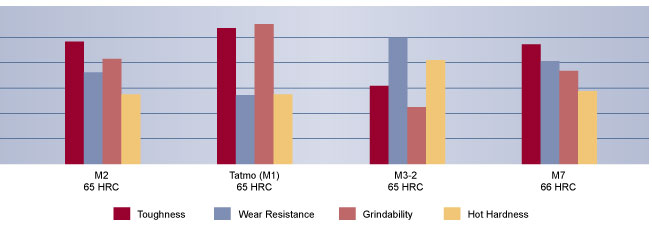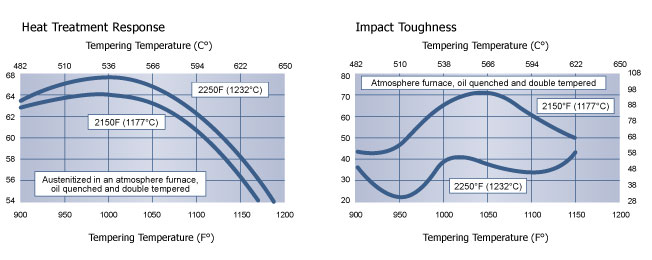M2 High Speed Steel
M2 High Speed Steel (M2) is a tungsten-molybdenum high speed steel with a well balanced composition suitable for a wide variety of applications. World wide, the M2 type is by far the most popular high speed steel having replaced T1 high speed in most applications because of its superior properties and relative economy.
APPLICATIONS: Twist drills, taps, milling cutters, reamers, broaches, saws, and knives.
Composition
| C | Mn | Si | Cr | W | Mo | V |
| 0.85 | 0.28 | 0.30 | 4.15 | 6.15 | 5.00 | 1.85 |
Relative Properties


Physical Properties
- Density: 0.294 lb/in3 (8138 kg/m3)
- Specific Gravity: 8.14
- Modulus of Elasticity: 30 x 106 psi (207GPa)
- Machinability: 50-60% of a 1% carbon steel

Heat Treating Instructions
Hardening
| Critical Temperature: | |
| Ac1: 1530°F (832°C) | Ac3: 1610°F (877°C) |
| Ar1: 1430°F (777°C) | Ar3: 1380°F (749°C) |
Preheating: To minimize distortion and stresses in large or complex tools use a double preheat. Heat at a rate not exceeding 400°F per hour (222°C per hour) to 1100°F (593°C) equalize, then heat to 1450-1550°F (788-843°C). For normal tools, use only the second temperature range as a single preheating treatment.
Austenitizing (High Heat): Heat rapidly from the preheat.
For Cutting Tools:
Furnace: 2200-2250°F (1204-1232°C)
Salt: 2175-2225°F (1191-1218°C)
To maximize toughness, use the lowest temperature.
To maximize hot hardness, use the highest temperature.
For punches, dies, and tools that require maximum
toughness without hot hardness:
Furnace: 2075-2175°F (1175-1191°C)
Salt: 2050-2150°F (1121-1177°C)
Quenching: Pressurized gas, warm oil, or salt. For pressurized gas, a rapid quench rate to below 1000°F (538°C) is critical to obtain the desired properties. For oil, quench until black, about 900°F (482°C), then cool in still air to 150 -125°F (66-51°C). For salt maintained at 1000-1100°F (538-593°C), equalize, then cool in still air to 150 -125°F (66-51°C).
Tempering: Temper immediately after quenching. Typical tempering range is 1025-1050°F (552-566°C). Hold at temperature for 2 hours, then air cool to ambient temperature. Double tempering is required. For large cross sections, and especially for blanks from which tools will be cut by wire EDM, triple tempering is strongly recommended.
Annealing
Annealing must be performed after hot working and before re-hardening.
Heat at a rate not exceeding 400°F per hour (222°C per hour) to 1525-1550°F (829-843°C), and hold at temperature for 1 hour per inch (25.4 mm) of thickness, 2 hours minimum. Then cool slowly with the furnace at a rate not exceeding 50°F per hour (28°C per hour) to 1000°F (538°C). Continue cooling to ambient temperature in the furnace or in air. The resultant hardness should be 248 HBW or lower.